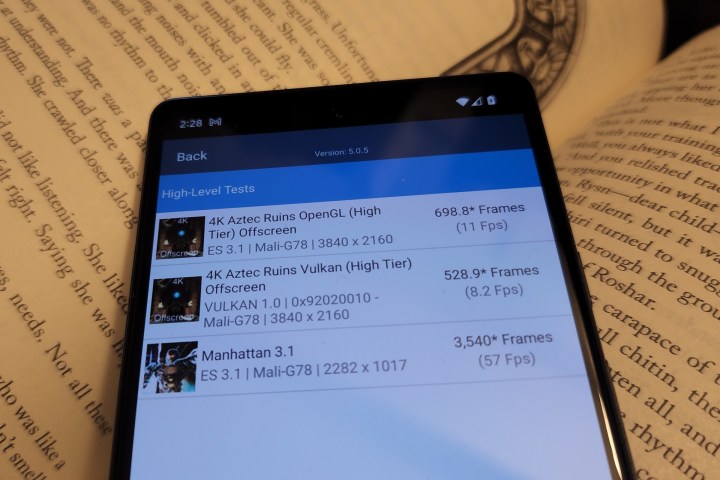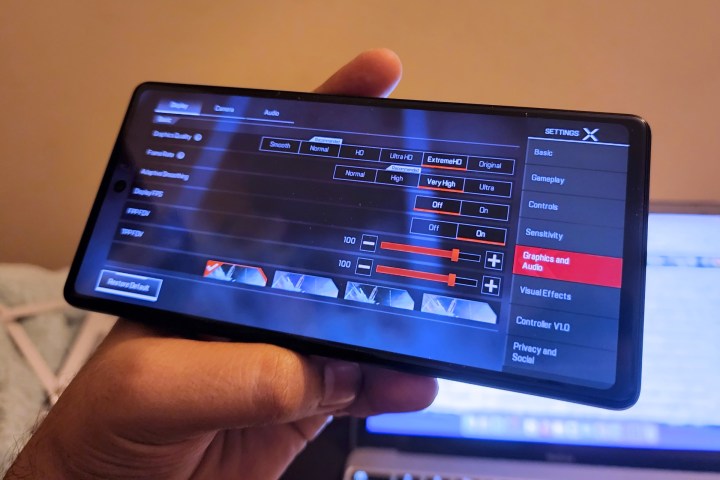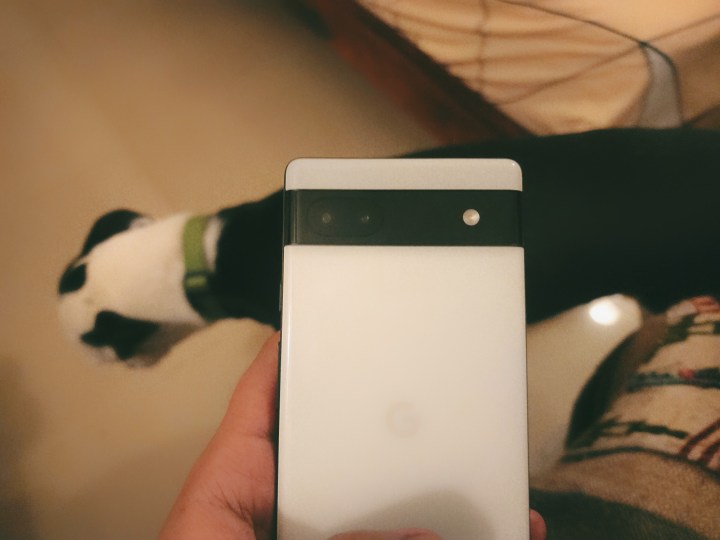The Google Pixel 6a has won laurels as one of the best budget phones available if you live in the U.S. market. For $450, it offers a standout design, a pair of reliable cameras, clean software, some neat exclusive tricks, and a whole lot of Tensor firepower.
Google’s Tensor chip is plenty powerful to handle even the most demanding workflow. In my own experience, it hasn’t left me hanging with any aggressive background task management, and I haven’t come across any concerning lags either. However, gaming is something that the Pixel 6a falters at, and in rather odd ways.
A capable chip on paper and in practice
On paper, Tensor is nothing short of a behemoth, and technically, it should outperform the best processors out there. The Tensor chip packs two high-end Cortex X1 cores for heavy lifting, a pair of mid-range Cortex-A76 cores, and four Cortex-A55 cores for less demanding tasks.

If you compare it with the Snapdragon 888, the Qualcomm chip offers a single Cortex-X1 core, a trio of Cortex-A78 cores, and four Cortex-A55 cores. The core architecture of Samsung’s Exynos 2100 isn’t different either. Yet, the Galaxy S21 — which came out in 2021 — races ahead of the Pixel 6a on AnTuTu, GFXBench Manhattan 3.1 (on-screen), and Geekbench 5.
When compared to more recent phones like the Galaxy S22 that rely on the Snapdragon 8 Gen 1, the Tensor chip inside Pixel 6a is left far behind. Comparing it with the A15 Bionic at synthetic benchmarks yields a similar story.
But we are often told that benchmarks are not the real story of how a phone performs. That’s especially fitting for the Pixel 6a. Over the past few weeks, I’ve used the phone heavily as my daily driver and haven’t come across a single performance-related red flag. The phone managed to run anywhere between 15 to 20 apps in the background with ease.

It’s a flagship chip by design but doesn’t really keep up with the flagship peers from Apple or Qualcomm. Of course, a lot also depends on the thermal hardware and the display tech allowance, if one plans to compare the gaming performance of the Pixel 6a with any other flagship phone. That’s exactly where the Pixel 6a falters.
What it’s like gaming on the Pixel 6a
I started with casual, less-demanding games like The Battle Cats, Bistro Heroes, and Stardew Valley. The Pixel 6a breezed past these games without any noticeable heating or battery drain. The games ran smoothly and, barring internet issues, there were no hiccups during the gaming session.
However, things change as you switch to more demanding games. From the get-go, I couldn’t help but notice that things felt sluggish. Games take longer to load, and the additional assets also take more time to install, even compared to Android mid-rangers like the Nothing Phone 1 powered by the Qualcomm Snapdragon 778G+.

You might also run into a weird scaling issue in some games. Take a look at the blank bars on either side of the screen (image above) while playing Injustice 2. Mortal Kombat was no exception. But before we delve into a title-by-title experience of challenging games, here’s what players need to keep in mind.
You will have to compromise on either graphics quality or raw frame rate numbers. If you want the best visual experience, you better stick with moderate to high fps preset instead of Ultra or Extreme options for graphics quality.
Even in a room with the temperature set at a cool 60-degree Fahrenheit, the CPU temperature went up by 11 degrees F after just 15 minutes of playing PUBG spin-off New State. As for graphics settings, playing the game with graphics settings set to Ultra (maximum permissible is Extreme) and frame rate set to Max (maximum possible is 90 fps), the gameplay experience was acceptable.

However, frame drops are still visible every now and then. During intense combat scenes, I noticed stutters, too. Another vexing aspect is that almost every UI element seems to load slower than expected, especially if you’ve played the same game on another Android flagship or iPhone.
That becomes especially annoying if a game like Genshin Impact throws a massive 16GB installation package your way. Unpacking and installing even the heavy update packages take more time than it should for a processor that is as capable as the Tensor.
In a room with the temperature set at 73 degrees Fahrenheit, even unpacking the first download package for Diablo Immortal caused a lot of heating within a few minutes. Then there are system restrictions. For example, you can’t set the image resolution to Ultra, and image sharpening doesn’t really make a tangible difference.

As for the core experience, I maxed out anti-aliasing, visual effects, shadows, environmental details, and monster details in the game, and came out with a mostly positive experience. There were a few jitters, again during the intense combat scenes, and the CPU temperature shot all the way up to 112-degree Fahrenheit.
A rudimentary version of Gamebench test revealed that the frame stability is a paltry 60% to 65% for taxing games like Call of Duty: Mobile and Shadowgun Legends. Any title beyond that category, such as Genshin Impact, Fortnite, and Apex Legends, delivers worse results.
Apex Legends turned out to be an exception, though. Frame drops were far and few, and I didn’t notice any serious stuttering even with the Frame rate set to Ultra and Dynamic Shadows enabled. As for the frame rate count, it remained at a stable 60 range throughout the test rounds.

The battery temperature also touched the 107-degree Fahrenheit mark within just 10 minutes of playing Diablo Immortal. Needless to say, heating is a serious problem, and it’s hard to ignore even if the gameplay experience is rewarding, barring a few stutters. The battery drain situation is also concerning, as the phone burned through 13% of ionic fuel in just about 10 minutes.
Tensor trouble
The Pixel 6a can handle ‘almost’ any demanding game you throw at it with ease, and you won’t find the experience sub-par unless you compare the experience with a current-gen flagship like the Galaxy S22 Ultra or the iPhone 13 Pro.

Aiming for extreme frame rates with HDR visuals? Lower your expectations. If you’re after a smooth gaming experience with minimal stuttering, frame drops, and crisp visuals, the Pixel 6a will serve you well. Just make sure that you’re not sitting in the sun while playing a game like Genshin Impact, otherwise, things get toasty rather quickly.
Another issue is throttling. With 20 CPU threads active for 15 minutes straight, Tensor throttled to as low as 54% of its peak performance. In comparison, the Poco F4 – which technically features a two-year-old Qualcomm chip – never dipped below the 90% mark. Check out the CPU throttling graph of the Google Pixel 6a in the image above.
Tensor, a tale of poor optimization
Running the CPU throttling test for separate test durations of 15, 30, and 45 minutes also yielded a performance graph that continuously declined from start to finish without any significant spell of stability. Now, compare the Pixel 6a’s sloping (read: bad throttling) graph with the relatively stable output from the Poco F4 in the image below:

Even the Snapdragon 8 Gen 1, which has courted a bad rep for poor performance optimization and temperature management, performed far better than the Tensor. When running the same throttling test on the Galaxy S22 Ultra, the CPU frequency never dipped below the 80% mark, and there were no red bars for alarming temperature spikes either.
There are also optimization issues. Gamebench, which offers the most comprehensive set of game performance testing tools, was incompatible with the Android 13 (64-bit, ARMv8 architecture) build running on the Pixel 6a. Likewise, trying to run some of the demanding 3DMark tests returned an error for unexplained reasons.
Annoyingly, the native Game Dashboard that is exclusive to Pixel phones has also vanished from the Pixel phones. The feature lets you keep an eye on metrics like FPS count and set performance profiles. After being exclusive to the Pixel 6 and its Pro sibling, it began rolling out for Pixel 6a in August, but it’s no longer available.

I tried to enable it while running the stable build of Android 13 (with August security patch) and also after registering with Google’s Android 13 beta program, but couldn’t find the feature. On the other hand, the third-party FPS counter and performance monitoring apps are either grossly inaccurate, or not optimized for chips other than those made by Qualcomm or MediaTek.
You can push the Pixel 6a, but you shouldn’t
The Pixel 6a is a very odd phone for gaming. It comes armed with a fairly powerful processor, and that ideally shouldn’t let you down irrespective of the game you throw at it. But alas, that’s not really the case, because there are caveats you should be aware of.
The dominant problem with gaming on the Pixel 6a is not the lack of raw firepower, but poor optimization for the Tensor chip. It explains why some benchmark tests won’t run, there are stability issues with games, throttling is commonplace, and the heat management is pretty bad.

I tested phones such as the Poco F4 5G and the Nothing Phone 1, both of which feature a less powerful processor than the Tensor, but a significantly better experience at gameplay smoothness and heat management. Then comes the throttling issue.
Technically, you can max out the graphics settings in a majority of demanding games, and still get a smooth experience, but the heating in the upper half would be hard to ignore. However, if you temper your expectations just a little bit in terms of graphics quality, and keep things just a notch below the Ultra or Extreme settings, you will have a delightful time playing games on the Pixel 6a.
The only other phone in the U.S. market which can match the gaming prowess of the Pixel 6a is the iPhone SE (2022). The rest of the midrange rivals from Motorola, TCL, and Samsung can’t catch up with the Tensor chip’s capabilities inside the Pixel 6a. That means the Pixel 6a still has a leg to stand on for a gaming handset in this price range, but assuming we get a Pixel 7a in 2023 with Tensor 2, there’s still ample room for improvement.
Editors’ Recommendations








